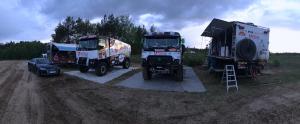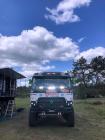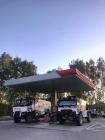MKR reduces the temperature and weight of their trucks
14.6.2021
 Speed up, better manage heat, reduce weight and ensure the greatest possible comfort for the crew both during the race on unpredictable long-distance tracks and in case of necessary replacements. Such a task was set by the North Bohemian designers of Dakar trucks at their MKR Technology development center in Chvalín. And they are on track to make it. The team boss Mario Kress is satisfied with the tests of the last days.
Speed up, better manage heat, reduce weight and ensure the greatest possible comfort for the crew both during the race on unpredictable long-distance tracks and in case of necessary replacements. Such a task was set by the North Bohemian designers of Dakar trucks at their MKR Technology development center in Chvalín. And they are on track to make it. The team boss Mario Kress is satisfied with the tests of the last days.
"Step by step, we are successfully following implementation of all our ideas, and tests have shown that we are progressing very well in terms technology. We are constantly learning and still responding to all the pitfalls that may have arise, and we are good at tuning, simplifying all the systems and at the same time we are working on their durability. Overall, we are satisfied, but we also know that there is still a lot of work ahead of us that we would like to do," said Mario Kress, chief designer and head of the MKR Technology team.
Last week, the designers of MKR Technology tested the trucks of the Dutch team Riwald Dakar on sandy tracks in Poland. They had both black-and-white Renaults with them, i.e. the unique hybrid model C 460 of pilot Gert Huzink, and Pascal de Baar’s K520. "This year's Dakar has shown us what we need to improve. And it’s lot of it," smiled Mario Kress, who has worked with his team in recent months to improve the intercooler and the engine's overall heat exchange system. "Tests have shown that the ventilation in the intercooling system is seventeen degrees colder, which is a huge effect," said Kress, who struggled a lot with the racing special overheating.
The has team also changed the gearbox and reduced the overall weight by more than two hundred kilos. Attention is turned to shock absorbers and suspension. The trucks should be as comfortable as possible for the crew, who spend long hours in the field and on rocky roads, but the ride as such is dynamic. "Here, we have moved improved by some ten percent as well," compares Mario Kress, who plans to compare all the trucks that his team is constantly developing. That is why he will undergo further testing in the Netherlands next week, this time with the Mammoet Rallysport team with Martin van den Brink. "Now we were on sandy surface. The measurement showed how we were able to accelerate thanks to all the changes, but we still need to try bigger jumps and a harder surface on different tracks. Dakar is about all the extremes and we want to be as prepared as possible," said Mario Kress.
After all the modifications and changes, the designers praise the better reactions, response, acceleration and dynamic behavior. But together they are also working to improve the conditions for the crew in the event of classic technical difficulties on the track. "We are also working on a better system in case of punctures, so that they can replace them as easily and quickly as possible and continue again," said Kress, who is constantly improving the hybrid system itself, in which he sees a great future.
In addition, after the January Dakar and a race pause, the team is soon to jump into racing again. In July, Martin van den Brink's red truck will race at the traditional Silk Way Rally.













